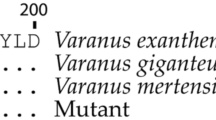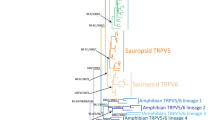Abstract
Tetrodotoxin (TTX) is a potent toxin that specifically binds to voltage-gated sodium channels (NaV). TTX binding physically blocks the flow of sodium ions through NaV, thereby preventing action potential generation and propagation. TTX has different binding affinities for different NaV isoforms. These differences are imparted by amino acid substitutions in positions within, or proximal to, the TTX-binding site in the channel pore. These substitutions confer TTX-resistance to a variety of species. The garter snake Thamnophis sirtalis has evolved TTX-resistance over the course of an arms race, allowing some populations of snakes to feed on tetrodotoxic newts, including Taricha granulosa. Different populations of the garter snake have different degrees of TTX-resistance, which is closely related to the number of amino acid substitutions. We tested the biophysical properties and ion selectivity of NaV of three garter snake populations from Bear Lake, Idaho; Warrenton, Oregon; and Willow Creek, California. We observed changes in gating properties of TTX-resistant (TTXr) NaV. In addition, ion selectivity of TTXr NaV was significantly different from that of TTX-sensitive NaV. These results suggest TTX-resistance comes at a cost to performance caused by changes in the biophysical properties and ion selectivity of TTXr NaV.






Similar content being viewed by others
Abbreviations
- NaV:
-
Sodium channel
- TTX:
-
Tetrodotoxin
- TTXr:
-
Tetrodotoxin-resistant
- TTXs:
-
Tetrodotoxin-sensitive
- P-region:
-
Sodium channel pore
- DI-DIV:
-
Domains I–IV
- S1-6:
-
Transmembrane segments 1–6
- WT:
-
Wild type
- BL:
-
Bear Lake (TTX-sensitive)
- WA:
-
Warrenton (TTX-resistant)
- WC:
-
Willow Creek (highly TTX-resistant)
- mV:
-
Millivolts
References
Armstrong CM (2006) Na channel inactivation from open and closed states. Proc Natl Acad Sci USA 103:17991–17996
Benitah JP, Ranjan R, Yamagishi T, Janecki M, Tomaselli GF, Marban E (1997) Molecular motions within the pore of voltage-dependent sodium channels. Biophys J 73:603–613
Benitah JP, Chen Z, Balser JR, Tomaselli GF, Marban E (1999) Molecular dynamics of the sodium channel pore vary with gating: interactions between P-segment motions and inactivation. J Neurosci 19:1577–1585
Bezanilla F (2008) How membrane proteins sense voltage. Nat Rev Mol Cell Biol 9:323–332
Brodie EDI, Brodie EDJ (1999) Costs of exploiting poisonous prey: evolutionary trade-offs in a predator-prey arms race. Evolution 53:626–631
Brodie EDJ, Hensel JLJ, Johnson JA (1974) Toxicity of the urodele amphibians Taricha, Notophthalmus, Cynops and Paramesotriton (Salamandridae). Copeia 1974:506–511
Catterall WA, Goldin AL, Waxman SG (2005) International union of pharmacology. XLVII. Nomenclature and structure-function relationships of voltage-gated sodium channels. Pharmacol Rev 57:397–409
Cha A, Ruben PC, George AL, Fujimoto E, Bezanilla F (1999) Voltage sensors in domains III and IV, but not I and II, are immobilized by Na channel fast inactivation. Neuron 22:73–87
Chahine M, Bennett PB, George AL Jr, Horn R (1994) Functional expression and properties of the human skeletal muscle sodium channel. Pflügers Arch 427:136–142
Chanda B, Bezanilla F (2002) Tracking voltage-dependent conformational changes in skeletal muscle sodium channel during activation. J Gen Physiol 120:629–645
Chanda B, Asamoah OK, Bezanilla F (2004) Coupling interactions between voltage sensors of the sodium channel as revealed by site-specific measurements. J Gen Physiol 123:217–230
Chang NS, French RJ, Lipkind GM, Fozzard HA, Dudley S Jr (1998) Predominant interactions between [mu]-conotoxin Arg-13 and the skeletal muscle Na+ channel localized by mutant cycle analysis. Biochemistry 37:4407–4419
Chiamvimonvat N, Perez-Garcia MT, Tomaselli GF, Marban E (1996) Control of ion flux and selectivity by negatively charged residues in the outer mouth of rat sodium channels. J Physiol 491:51–59
Choudhary G, Yotsu-Yamashita M, Shang L, Yasumoto T, Dudley SC (2003) Interactions of the C-11 hydroxyl of tetrodotoxin with the sodium channel outer vestibule. Biophys J 84:287–294
Clare JJ, Tate SN, Nobbs M, Romanos MA (2000) Voltage-gated sodium channels as therapeutic targets. Drug Discov Today 5:506–520
Cummins TR, Dib-Hajj SD, Black JA, Akopian AN, Wood JN, Waxman SG (1999) A novel persistent tetrodotoxin-resistant sodium current in SNS-null and wild-type small primary sensory neurons. J Neurosci 19(RC43):1–6
Eaholtz G, Scheuer T, Catterall WA (1994) Restoration of inactivation and block of open sodium channels by an inactivation gate peptide. Neuron 12:1041
Favre I, Moczydlowski E, Schild L (1996) On the structural basis for ionic selectivity among Na+, K+, and Ca2+ in the voltage-gated sodium channel. Biophys J 71:3110–3125
Featherstone DE, Richmond JE, Ruben PC (1996) Interaction between fast and slow inactivation in Skm1 sodium channels. Biophys J 71:3098–3109
Featherstone DE, Fujimoto E, Ruben PC (1998) A defect in skeletal muscle sodium channel deactivation exacerbates hyperexcitability in human paramyotonia congenita. J Physiol 506:627–638
Geffeney S, Brodie ED Jr, Ruben PC, Brodie ED 3rd (2002) Mechanisms of adaptation in a predator-prey arms race: TTX-resistant sodium channels. Science 297:1336–1339
Geffeney SL, Fujimoto E, Brodie EDI, Brodle EDJ, Ruben PC (2005) Evolutionary diversification of TTX-resistant sodium channels in a predator-prey interaction. Nature 434:759–763
Gellens ME, George AL Jr, Chen LQ, Chahine M, Horn R, Barchi RL, Kallen RG (1992) Primary structure and functional expression of the human cardiac tetrodotoxin-insensitive voltage-dependent sodium channel. Proc Natl Acad Sci USA 89:554–558
Hayward LJ, Brown RH, Cannon SC (1997) Slow inactivation differs among mutant Na channels associated with myotonia and periodic paralysis. Biophys J 72:1204–1219
Hilber K, Sandtner W, Kudlacek O, Glaaser IW, Weisz E, Kyle JW, French RJ, Fozzard HA, Dudley SC, Todt H (2001) The selectivity filter of the voltage-gated sodium channel is involved in channel activation. J Biol Chem 276:27831–27839
Hilber K, Sandtner W, Zarrabi T, Zebedin E, Kudlacek O, Fozzard HA, Todt H (2005) Selectivity filter residues contribute unequally to pore stabilization in voltage-gated sodium channels. Biochemistry 44:13874–13882
Hille B (1971) The permeability of the sodium channel to organic cations in myelinated nerve. J Gen Physiol 58:599–619
Hille B (1972) The permeability of the sodium channel to metal cations in myelinated nerve. J Gen Physiol 59:637–658
Hille B (2001) Ion channels of excitable membranes, 3rd edn. Sinauer, Sunderland
Horn R, Ding S, Gruber HJ (2000) Immobilizing the moving parts of voltage-gated ion channels. J Gen Physiol 116:461–476
Jayne BC, Bennett AF (1990) Selection on locomotor performance capacity in a natural population of garter snakes. Evolution 44:1204–1229
Jost MC, Hillis DM, Lu Y, Kyle JW, Fozzard HA, Zakon HH (2008) Toxin-resistant sodium channels: parallel adaptive evolution across a complete gene family. Mol Biol Evol 25:1016–1024
Kaneko Y, Matsumoto G, Hanyu Y (1997) TTX resistivity of Na+ channel in newt retinal neuron. Biochem Biophys Res Commun 240:651–656
Lipkind GM, Fozzard HA (2000) KcsA crystal structure as framework for a molecular model of the Na(+) channel pore. Biochemistry 39:8161–8170
Maruta S, Yamaoka K, Yotsu-Yamashita M (2007) Two critical residues in P-loop regions of puffer fish Na+ channels on TTX sensitivity. Toxicon 51(3):381–387
Mitrovic N, George AL, Horn R (2000) Role of domain 4 in sodium channel slow inactivation. J Gen Physiol 115:707–718
Noda M, Suzuki H, Numa S, Stuhmer W (1989) A single point mutation confers tetrodotoxin and saxitoxin insensitivity on the sodium channel II. FEBS Lett 259:213–216
Ong BH, Tomaselli GF, Balser JR (2000) A structural rearrangement in the sodium channel pore linked to slow inactivation and use dependence. J Gen Physiol 116:653–662
Pathak M, Kurtz L, Tombola F, Isacoff E (2004) The cooperative voltage sensor motion that gates a potassium channel. J Gen Physiol 125:57–69
Pauling L (1960) The nature of the chemical bond and the structure of molecules and crystals: an introduction to modern structural chemistry. Cornell University Press, Ithaca
Penzotti JL, Fozzard HA, Lipkind GM, Dudley SC Jr (1998) Differences in saxitoxin and tetrodotoxin binding revealed by mutagenesis of the Na+ channel outer vestibule. Biophys J 75:2647–2657
Pérez-García MT, Chiamvimonvat N, Marban E, Tomaselli GF (1996) Structure of the sodium channel pore revealed by serial cysteine mutagenesis. Proc Natl Acad Sci USA 93:300–304
Pérez-García MT, Chiamvimonvat N, Ranjan R, Balser JR, Tomaselli GF, Marban E (1997) Mechanisms of sodium/calcium selectivity in sodium channels probed by cysteine mutagenesis and sulfhydryl modification. Biophys J 72:989–996
Richmond JE, VanDeCarr D, Featherstone DE, George AL, Ruben PC (1997) Defective fast inactivation recovery and deactivation account for sodium channel myotonia in the I1160V mutant. Biophys J 73:1896–1903
Ruben PC, Starkus JG, Rayner MD (1990) Holding potential affects the apparent voltage-sensitivity of sodium channel activation in crayfish giant axons. Biophys J 58:1169–1181
Ruben PC, Starkus JG, Rayner MD (1992) Steady-state availability of sodium channels. Interactions between activation and slow inactivation. Biophys J 61:941–955
Santarelli VP, Eastwood AL, Dougherty DA, Horn R, Ahern CA (2007) A cation-pi interaction discriminates among sodium channels that are either sensitive or resistant to tetrodotoxin block. J Biol Chem 282:8044–8051
Satin J, Kyle JW, Chen M, Bell P, Cribbs LL, Fozzard HA, Rogart RB (1992) A mutant of TTX-resistant cardiac sodium channels with TTX-sensitive properties. Science 256:1202–1205
Stefani E, Bezanilla F (1998) Cut-open oocyte voltage-clamp technique. Methods Enzymol 293:300–318
Strausberg RL, Feingold EA, Grouse LH, Derge JG, Klausner RD, Collins FS, Wagner L, Shenmen CM, Schuler GD, Altschul SF (2002) Generation and initial analysis of more than 15,000 full-length human and mouse cDNA sequences. Proc Natl Acad Sci USA 99:16899–16903
Terlau H, Heinemann SH, Stuhmer W, Pusch M, Conti F, Imoto K, Numa S (1991) Mapping the site of block by tetrodotoxin and saxitoxin of sodium channel II. FEBS Lett 293:93–96
Todt H, Dudley SC, Kyle JW, French RJ, Fozzard HA (1999) Ultra-slow inactivation in 1 Na+ channels is produced by a structural rearrangement of the outer vestibule. Biophys J 76:1335–1345
Tomaselli GF, Chiamvimonvat N, Nuss HB, Balser JR, Perez-Garcia MT, Xu RH, Orias DW, Backx PH, Marban E (1995) A mutation in the pore of the sodium channel alters gating. Biophys J 68:1814–1827
Tsushima RG, Li RA, Backx PH (1997) Altered ionic selectivity of the sodium channel revealed by cysteine mutations within the pore. J Gen Physiol 109:463–475
Vedantham V, Cannon SC (2000) Rapid and slow voltage-dependent conformational changes in segment IVS6 of voltage-gated Na+ channels. Biophys J 78:2943–2958
Venkatesh B, Lu SQ, Dandona N, See SL, Brenner S, Soong TW (2005) Genetic basis of tetrodotoxin resistance in pufferfishes. Curr Biol 15:2069–2072
Vilin YY, Fujimoto E, Ruben PC (2001) A single residue differentiates between human cardiac and skeletal muscle Na+ channel slow inactivation. Biophys J 80:2221–2230
Wang JZ, Rojas CV, Zhou JH, Schwartz LS, Nicholas H, Hoffman EP (1992) Sequence and genomic structure of the human adult skeletal muscle sodium channel alpha subunit gene on 17q. Biochem Biophys Res Commun 182:794–801
Xiong W, Farukhi YZ, Tian Y, DiSilvestre D, Li RA, Tomaselli GF (2006) A conserved ring of charge in mammalian Na channels: a molecular regulator of the outer pore conformation during slow inactivation. J Physiol 576:739–754
Yang YC, Hsieh JY, Kuo CC (2009) The external pore loop interacts with S6 and S3–S4 linker in domain 4 to assume an essential role in gating control and anticonvulsant action in the Na+ channel. J Gen Physiol 134:95–113
Yotsu-Yamashita M, Nishimori K, Nitanai Y, Isemura M, Sugimoto A, Yasumoto T (2000) Binding properties of (3)H-PbTx-3 and (3)H-saxitoxin to brain membranes and to skeletal muscle membranes of puffer fish Fugu pardalis and the primary structure of a voltage-gated Na(+) channel alpha-subunit (fMNa1) from skeletal muscle of F. pardalis. Biochem Biophys Res Commun 267:403–412
Acknowledgments
This research was funded by a NSERC Discovery Grant to PCR. The authors thank Dr. Yuriy Vilin for invaluable assistance. Animals were housed and handled according to regulations established by the University Animal Care Committee and the Canadian Council on Animal Care.
Author information
Authors and Affiliations
Corresponding author
Rights and permissions
About this article
Cite this article
Lee, C.H., Jones, D.K., Ahern, C. et al. Biophysical costs associated with tetrodotoxin resistance in the sodium channel pore of the garter snake, Thamnophis sirtalis . J Comp Physiol A 197, 33–43 (2011). https://doi.org/10.1007/s00359-010-0582-9
Received:
Revised:
Accepted:
Published:
Issue Date:
DOI: https://doi.org/10.1007/s00359-010-0582-9




